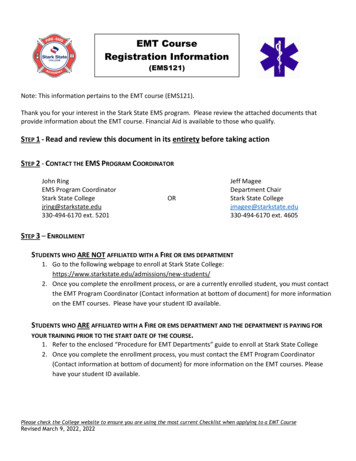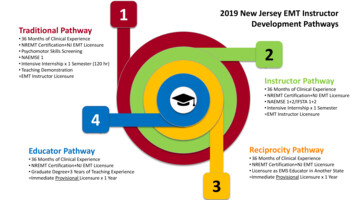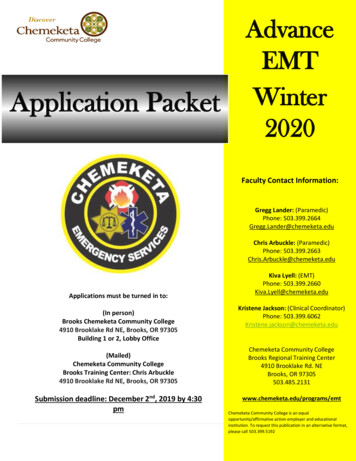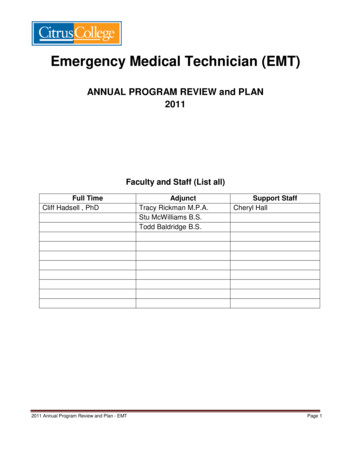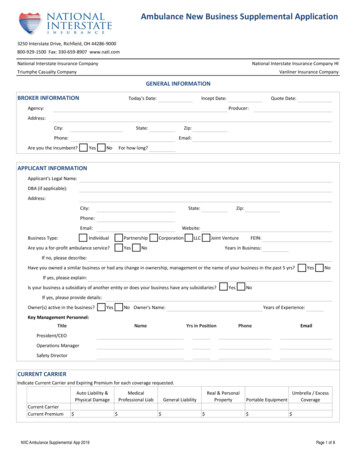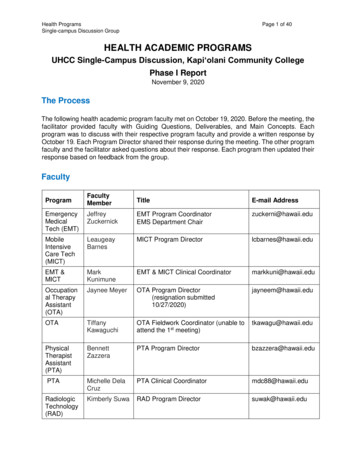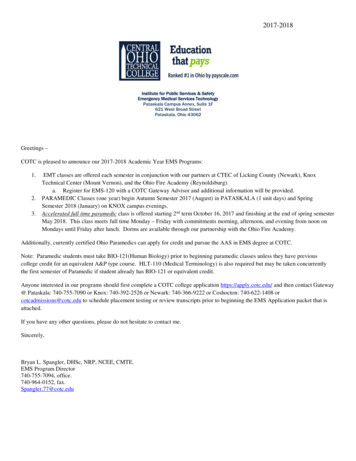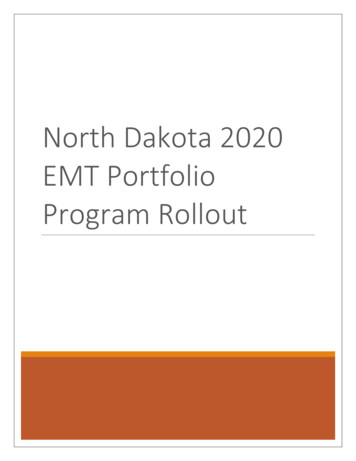
Transcription
North Dakota 2020EMT PortfolioProgram Rollout
ContentsOur Mission: Project Vision and Goals .2Portfolio Contents .3Suggested Lab Schedule .1Psychomotor Exam .2Video Links.2Room Layout.2Personnel Needed .3Equipment Needed.3Sample Equipment.4Additional Equipment .5Course Verification Visits for Independent Courses .61
Our Mission: Project Vision and GoalsOur mission is to prepare competent, entry-level, Emergency MedicalTechnicians in the cognitive (knowledge), psychomotor (skills), and affective(behavior) learning domains. Our goal is to provide a valid, uniform process toassess the knowledge and skills required for competent practice by EMSprofessionals throughout their careers. The curriculum is guided by the UnitedStates Department of Transportation (DOT) and National Highway Traffic SafetyAdministration (NHTSA). Students may practice all the skills defined in the corescope of practice for emergency medical technician while under directsupervision of an instructor or the field internship preceptor and if registeredwith the Department of Health (NDDoH) as an emergency medical technicianstudent. At the completion of this course, students must show a completedportfolio, and a terminal competency document that outlines their skills,classroom performance, and passing grades on final exams for the knowledgeand psychomotor portions of the program. After the course, the student mustpass the national registry cognitive knowledge examination in order to beeligible for North Dakota EMT licensure.2
Portfolio ContentsA completed portfolio is required by each EMT student prior to NREMT certification testing. It is the course coordinator’sresponsibility to ensure entry level competency and portfolio completion. NREMT examinations are not a form of determiningpass/fail criteria for your course but a national certification exam to be exercised only after a student has successfully passedthe course by completing all requirements and minimal competencies.EMT Portfolio contents must include documentation for the completion of: Valid BLS Provider CPR certification10 live patient contacts (in areas with limited clinical availability, or during crisis situations, this requirement may bemet by additional simulation exercises with live simulated patients upon approval of the NDDoH)Vital Signs assessment (BP, Pulse, Respiratory Rate, GCS, Blood Glucose, Lung Sounds)o Documentation of at least 10 of eachCertificates of completion for ICS-100, ICS-200, IS-700, IS-800, and a Hazardous Materials Awareness-Level trainingprogram that meets the requirements established in Occupational Safety and Health Administration (OSHA) 29 Codeof Federal Regulations (CFR) 1910.120 (q) (6) (i) (a-f) "First Responder Awareness Level" competencies.NREMT Skills including, but not limited to:o BVM ventilationo Bleeding Control/Shock Managemento IV Maintenanceo Cardiac Arrest/ AEDo Nebulized Medicationo Joint Immobilizationo Limited Advanced Airwayo Long Bone Immobilizationo Naloxone Administration (volumeo Medical Assessmentrestricting syringe)o Oxygen Administrationo Epinephrine Administration (volumeo Trauma Assessmentrestricting syringe)o Spinal Motion Restriction (4 total – eithero CPAPseated or supine method with 1o 12-Leadinstructor check off)o LucasSuccessful performance at least 6 times per skill, with 5 peer evaluations and then one conducted by aninstructor Scenario evaluations – medical and traumao 2 by peerso 1 by instructor – does not count as psychomotor final examSuccessful summative written examSuccessful summative psychomotor examSigned student acknowledgement of ND licensing process and NREMT recertification rulesTerminal competency form (see forms) signed by the course coordinator/lead instructor and the course medicaldirector to affirm all the above has occurred, that the student is entry level competent, and is ready for NREMTtesting/certification.Portfolios are to be stored electronically for a minimum of 5 years.3
Suggested Lab ScheduleThe following is a suggested lab schedule for a 16-week EMT Program with one extra week for scenario validation and the lastweek for final psychomotor and written testing. This schedule should be in coordination with the subject matter of that week’slecture. Additional time, outside of the scheduled lab period per week should be made available and published for thecompletion of peer-to-peer work. Students are advised that one hour of additional time is suggested per week. This may bemodified to shorter or longer course lengths as appropriate.Session #123456789101112131415161718Class 05/10/20191800-22005/12/2019SubjectNo ClassSkillsBLS Provider CPRInstructorDavid/ TravisAED, Cardiac Arrest Management, Lucas, Vital Signs, Pulses, (SAMPLEhistory, OPQRST)O2, BVM, OPA’s, NPAs, Supraglottic Airway, Lung Sounds, CPAP, Nebs,SuctionAmbulance cot, Stair Chair, KED , longboard, C-CollarsDavidPatient Assessment, Medical History Taking – introduce scenariobased assessmentsIV Set up, Epi Pen, GlucometerDavidScenario Based Assessment (Medical) Intro to scenario testingTravisSkills ReviewDavidPatient Assessment, Bleeding/Wounds/Shock, SplintingDavidSpring BreakScenario Based Assessment (Trauma)JaneSkills ReviewDavidPatient Assessment -MedicalDavidOB, ChildbirthJanePatient Assessment -TraumaDavidIntegrated Out-of-HospitalDavidIntegrated Out-of-HospitalRobertDavidDavidDavidPutting it all together and review/make-upFinal psychomotorexamTBDSuggested lab hours: 64 HoursSuggested open skill time outside of scheduled labs: 16 hours1
Psychomotor Exam Grading sheetso See Appendix for the Integrated Out-of-Hospital score sheet. These should be used during the psychomotortesting to score students for their final (summative) psychomotor exam.Final exam processo Licensed training institutions Institution based EMT programs will be allowed to perform their own internal final examinations andverification of portfolio completion. While not required, it is recommended that the examiner for the final psychomotor examination be adifferent faculty member from the lead instructor for the EMT course.o Independent instructorsIndependent instructors are also able to grade their own students’ performance through a final examprocess; however, a site visit will be required to verify that the portfolio process is being followed.This will include a records review and observation of a select number of final scenario exams. If an independent instructor affiliates his or her course with a training institution, the institution willbe responsible for the portfolio contents and final examinations. No site visit would be required.o Once the final is passed, and the Terminal Competency Form (TCF) is complete, it will be sent to the NDDoHfor approval on the NREMT website and the student will be able to take the cognitive exam.Video LinksIntegrated Out of Hospital (Medical) – https://youtu.be/-GIQtTZdYoQIntegrated Out of Hospital (Trauma) – https://youtu.be/GInM8LQ7U YRoom LayoutThe testing room needs to be set up with an initial contact area (where the student finds the patient), an evaluator table and asimulated ambulance. The student will verbalize how they would move the simulated patient from point A to point B. Thestudent and EMT helper should never actually lift the patient, to minimize chance of injury. When ready, the simulated patientcan stand and move to the simulated ambulance, after the EMT verbalizes how he/she would move him (i.e. Stand and pivot,sheet lift, pit/knee maneuver, etc.). Below are examples of how a simulated ambulance can be set up.2
Personnel NeededThree (3) people needed per station1. Examiner2. EMT Assistant3. Simulated Patient (for the cardiac arrest scenario, a mannequin will be used)Equipment NeededEquipment used during the class should match what will be used in the final testing. The NDDoH will not mandatespecific equipment other than what is necessary to adequately prepare the students for future patient care. Theinstructor must have, or have access to, all the equipment in the sample list on the next page. Whether these arededicated training equipment/supplies or from active ambulance services is left to the program’s discretion.3
Sample EquipmentEquipment Bag(s): This content may be contained in 1 bag (BLS Bag) or may be contained in multiple (O2 bag, trauma bag, firstin bag, etc.). Oropharyngeal airway (O -6)Nasopharyngeal airway (min pediatricsize - manikin max size)Blind insertion or supraglottic airwaydevices (adult and pediatric sizes)BVM with mask and connection tubing(adult and pediatric)Suction (bulb, rigid and flexible catheter)Oxygen cylinder with regulatorNon-invasive ventilationtechniqueso CPAPOxygen administration deviceso Nasal Cannulao Simple masko Partial non-rebreathermasko Mini nebulizerGlucometero Test stripso Lancetso Alcohol prep padso 2x2 gauzeo Band-AidsPenlightPulse OximetryTrauma shearsStethoscopeSphygmomanometer 4Intranasal atomization device (2)& necessary syringesTongue depressorSharps ContainerHemorrhage controlo pressure dressingo tourniqueto occlusive dressingo hemostatic agento abdominal pado 4 x 4 gauzeo KlingPPE- eye protection, face maskMedicationso Albuterolo Epinephrine (doselimiting syringe)o Oral Glucoseo Aspirin, chewable, nonenteric coatedpreferredo DuoDote 11 oratropine/pralidoximechloride auto-injectoro Naloxone (doselimiting syringe)o Nitroglycerin, 0.4 mg SLBlankets – 2 per exam room
Additional EquipmentThese items must be available for psychomotor skills practice and may be needed for the final psychomotor exambased on the scenario(s) selected: OB kit (bulb syringe, two cord clamps} Fracture stabilization (pelvic binder, rigid splints, traction splints} Cold packs Hot packs Eye shields Cervical collar (adjustable or various sized, adult and pediatric} Long backboard Short backboard or KED Task Trainers (simulation manikins appropriate for skills practice) Laptops with speakers and capabilities to play audio files Gloves Monitor capable of 12-lead imaging and simulated transmission AED5
Course Verification Visits for Independent CoursesGoals: To ensure that instructors understand and are following the requirements of the portfolio program and producingentry-level competent EMTs and to allow experienced instructors to share their ideas with those new to the processin a non-threatening way. This visit is required for each class taught outside of a licensed EMS training institution. State Representatives (SR)a. Qualificationsi. Licensed as a ND EMT (or higher) and a current ND EMS Instructor Coordinatorii. Experienced with portfolio-based courses1. Taught EMT classes as the lead instructor in a portfolio program2. Faculty in a currently accredited paramedic programiii. Have conducted at least one supervised course verification visit.iv. Approved by the NDDoHb. Financei. SR’s costs will be reimbursed by the NDDoH.ii. Neither the program nor the students will be charged for the state visit. Visit Processa. Schedulingi. Visit date/time needs to be coordinated with the NDDoH and a SR.ii. Should occur during a time that summative psychomotor exams are being administered.b. Visit agendai. Meet with lead instructor – ensure knowledge of process and portfolio program whileexchanging ideas1. How course taught2. Record retentionii. Portfolio review – electronic recordsiii. Meet with studentsiv. Meet with course sponsor or affiliated ambulance service (if appropriate)v. Observe summative psychomotor scenario exam of select studentsvi. Out brief with instructorc. Visit paperworki. Portfolio check worksheetii. Scenario observation rubric6
Visit the Department website for:1.2.3.4.5.6.Terminal Competency Form SampleSample student portfolioSample scenariosIntegrated Out-of-Hospital Score SheetState Representative Visit Packet (agenda, worksheets)Latest updates on the program7
i. Licensed as a ND EMT (or higher) and a current ND EMS Instructor Coordinator ii. Experienced with portfolio-based courses 1. Taught EMT classes as the lead instructor in a portfolio program 2. Faculty in a currently accredited paramedic program iii. Have conducted at least one supervised course verification visit. iv. Approved by the NDDoH b .
